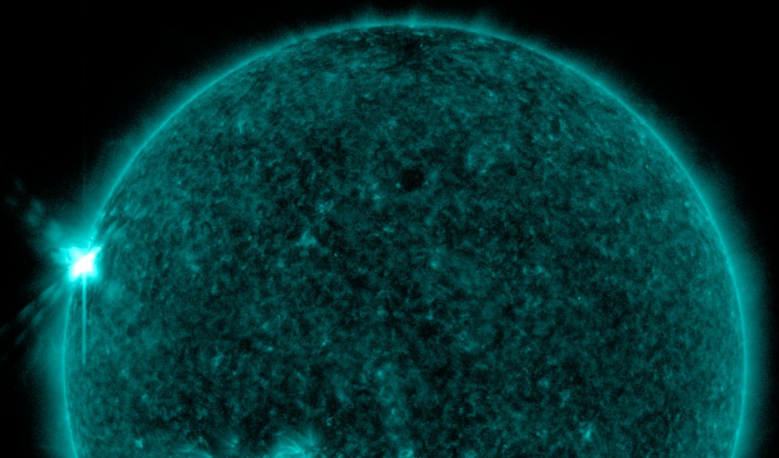Space weather experts are predicting that two violent eruptions of solar radiation blasted out from the sun 9 May, are heading to Earth and Mars in what is being called the largest solar flare of Solar Cycle 25 yet.
The Earth-bound eruption has been classed as weak compared to its Mars-directed counterpart but could result in an aurora at high latitudes on 12 May. It could also interfere with high frequency radio communications and GPS reception in regions such as Iceland, Brazil, Alaska and areas near to the UK.
The solar storm heading to the Red Planet is expected to arrive early on 11 May. This is in addition to a minor radiation storm that was also launched from the Sun at the same time. It will likely bathe Ingenuity and Perservance in a shower of radiation before the solar storm hits.
The solar storms have been captured on camera by the Large Angle and Spectrometric COronagraph (LASCO) instrument housed on the joint NASA/ESA SOHO (Solar and Heliospheric Observatory) spacecraft.
Launched in 1995, SOHO has been observing the Sun from an advantage point known as the First Lagrangian Point (L1), where the combined gravity of the Earth and Sun keep SOHO in an orbit locked to the Earth-Sun line.
Its LASCO instrument uses a set of three coronagraphs to image the solar corona by blocking out the light coming from the solar disk.
According to Dr Tamitha Skov, a space weather physicist, SOHO detected at least three solar storms that are now in transit in the inner heliosphere.
“Our star wakes up big time!” Skov said via Twitter. “According to early runs of the NASA prediction we could get a grazing hit early 12 May… Waiting for coronagraphs to refine predictions,” Skov said in a different post.
NASA’s Solar TErrestrial RElations Observatory (STEREO) mission, which consists of two identical spacecraft that were placed in two different orbits around the Sun, also caught the storms in action.
After examining coronagraph data from STEREO-A (contact with STEREO-B was lost in October 2014, eight years after the spacecraft launched) Erika Palmerio, a NASA LWS Postdoctural fellow at the University of California, Berkeley, who has also been keeping a watchful eye on the outburst says that a filament eruption from the Sun’s southern hemisphere is responsible for the first solar storm.
The second storm is a M3.9 class rupture flare that burst out from an already well-known active region known as AR 12822. It is propagating well away from Earth and heading towards Mars, Palmerio says.
Flares are classed according to strength in a similar way to how earthquakes are under the Richter scale. The smallest ones are A-class (near background levels), followed by B, C, M and X.
Each letter represents a 10-fold increase in energy output, so an X – which is the biggest – is ten times an M and 100 times a C. Within each letter class there is a finer scale from 1 to 9.
M-class flares can cause brief radio blackouts at the poles and minor radiation storms that might endanger astronauts. The most powerful solar flare in recorded observational history was an X28. It was captured on 4 November 200 bursting out of the Sun's surface at about 2300 kilometres per second (8.2 million km/h).
The Sun is currently in cycle 25. It left cycle 24 in September 2020 after it was declared that solar minimum had been reached in December 2019.
Scientists expect that the Sun’s activity in the latest cycle will continue to ramp up and reach its peak in 2025.
Solar storms are notoriously difficult to predict and for a species which is heavily reliant on technology, they have the potential to seriously disrupt many facets of our day to day life.
This is why NASA has recently selected five proposals for concept studies of missions to help improve understanding of the dynamics of the Sun. These include, Solar-Terrestrial Observer for the Response of the Magnetosphere (STORM); HelioSwarm: The Nature of Turbulence in Space Plasmas; Multi-slit Solar Explorer (MUSE); Auroral Reconstruction CubeSwarm (ARCS) and Solaris: Revealing the Mysteries of the Sun’s Poles.
The National Oceanic and Atmospheric Administration (NOAA) are also launching a Space Weather Follow-On (SWFO) satellite designed to make direct, in-situ, measurements of the solar wind thermal plasma and magnetic field “up-stream” of the Earth.
This will help provide warnings about potential space weather events that could play havoc with navigation and timing systems like the Global Positioning System (GPS) as well as electrical power grids.











